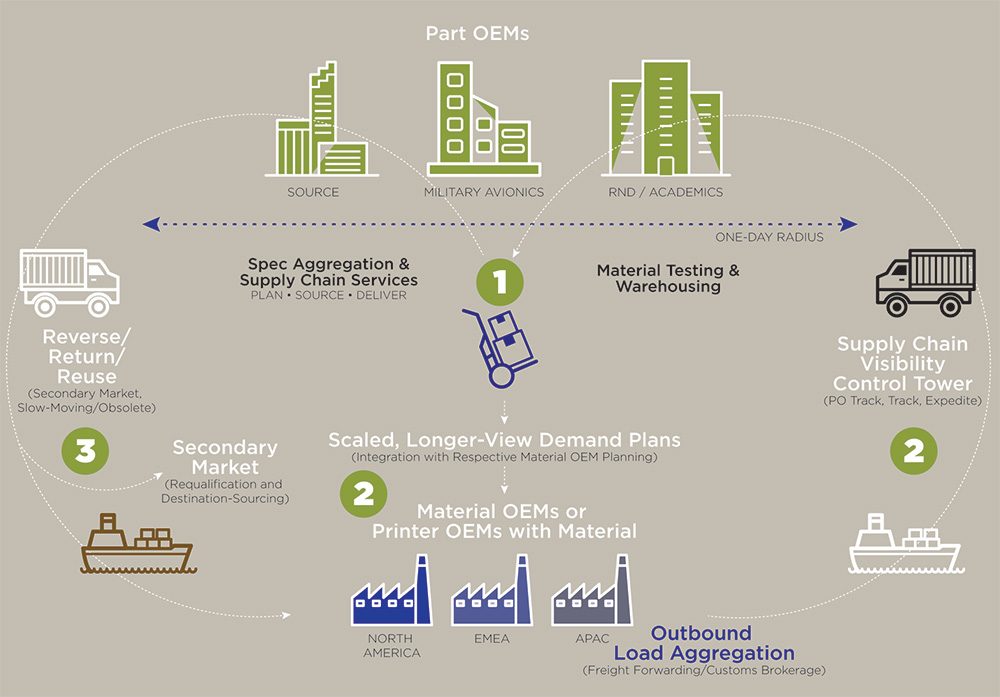GPO, proven effective as the standard operating model for the purchase and distribution of durables and consumables for multiple industries, can be applied to the emerging growth anticipated for the AM-materials supply chain. Developed GPOs have provided billions of dollars of value across those multiple industries, making an array of products available in proximity to point of use at aggregated, scaled, negotiated prices, while providing material producers with longer and aggregated views into the demand among consuming customers.
|
Here's a closed-loop Group Purchasing Organization (GPO) model, showing a hypothetical Southern California part-OEM part-material setup.
 1. In this member/customer-facing aspect of the GPO model, the GPO operator creates membership from various AM-part OEMs in a given geographic area, providing specification-database expertise in helping members select the right powders for the right applications, and making them aware of specifications made at scale where time- and cost-savings advantages may lie. 1. In this member/customer-facing aspect of the GPO model, the GPO operator creates membership from various AM-part OEMs in a given geographic area, providing specification-database expertise in helping members select the right powders for the right applications, and making them aware of specifications made at scale where time- and cost-savings advantages may lie.
2. The GPO operator then aggregates demand over the membership, plans time requirements for each member, and facilitates the purchase, movement, independent testing and local warehousing of material. When local members need material, short-haul delivery can replenish stocks to point-of-use.
3. As the GPO operator delivers, it also picks up unused or obsolete materials and arranges for its return (aggregated with others) for refurbishment or use by secondary markets.
|
Today’s GPO model has evolved from its origins in the 1970s and ’80s to a more comprehensive, supply-chain-as-a-service (SCaaS) solution. Services including member demand/supply planning; procurement; facilitated inbound logistics (warehousing/transportation); independent material testing; onsite inventory management; and end-of-life, closed-loop material management. The result generates economic value for producers and allows improved focus and leverage of key engineering talent whose time currently is split between core development/innovation/manufacturing and supply-chain material-management duties.
It’s not hard to imagine a future, if not here already, where material production-volume requirements make it impossible to live with continued escalating costs and uncapped lead times. It also isn’t hard, as a material manufacturer, to know that at some point there will be insufficient capital to continue as a pure make-to-order, unscaled production business.
To succeed, material suppliers must meet the immediate challenge of achieving visibility and continuity of supply. Doing so results in part manufacturers having access to materials in shorter timeframes, with materials located only hours or days away—not weeks or months.
How an AM-Material GPO Works
For its part, MatterProviders positions itself to provide GPO services with local warehousing and distribution infrastructure in the major U.S. AM production centers. In this model (see graphic below), the company will create GPO process capabilities among major part producers in a geographic area, provide aggregated planning and procurement services, and provision U.S.-based forward storage and inbound logistics services to customers on an as-required basis.
In a GPO, the material requirements of multiple consumers are aggregated and presented to material producers at scale, and with long-term visibility and commitment into future requirements, creating the opportunity for long-term value for both parties. The more members that join a GPO service model in a geographic area, the greater the value. Added features enabled by the scale include timelier and more frequent (smaller-scaled) deliveries to 3D printing shop floors. This enables better use of manufacturing space without additional company-owned and -managed overhead (for storing material) as well as efficient return, redistribution, remuneration and reconditioning of unused material.
While specification and purchase-volume aggregation are managed, members do not share specifications or other intellectual property, thus maintaining the necessary firewall protections for competitive differentiation.
In all, the lessons learned over decades of supply-chain leveraging via the GPO model, now updated for today’s best supply-chain practices as SCaaS, can be applied in assuring continual AM-material supply while reducing cost, waste and lead time. 3DMP
See also: MatterProviders
Technologies:
 Michelle Meyer
Michelle Meyer Greg Macaluso
Greg Macaluso





 1. In this member/customer-facing aspect of the GPO model, the GPO operator creates membership from various AM-part OEMs in a given geographic area, providing specification-database expertise in helping members select the right powders for the right applications, and making them aware of specifications made at scale where time- and cost-savings advantages may lie.
1. In this member/customer-facing aspect of the GPO model, the GPO operator creates membership from various AM-part OEMs in a given geographic area, providing specification-database expertise in helping members select the right powders for the right applications, and making them aware of specifications made at scale where time- and cost-savings advantages may lie.

 Podcast
Podcast